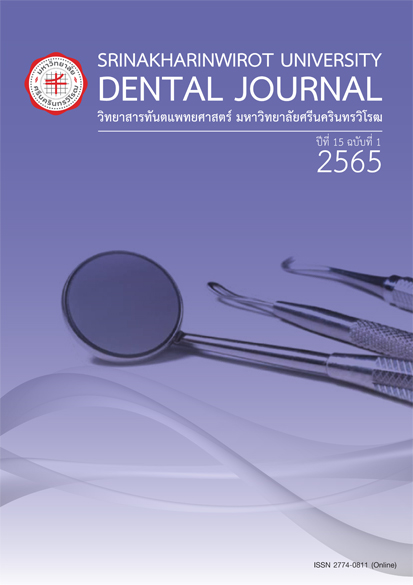Effect of Light on the Antibacterial Property of Silver Diamine Fluoride
Abstract
Objective: The study aimed to evaluate the antibacterial effect of shortened time and lightcuring on the biofilm of silver diamine fluoride (SDF) applied lesions.Materials and methods: Twenty dentin specimens (3 x 3 x 2 mm3) were prepared fromtwenty primary molar teeth with caries extended to the middle third of dentin. The specimens wererandomly allocated into 4 groups (n = 5/group); 1) distilled water (DW, negative control), 2) SDF10 seconds, 3) SDF 10 seconds with light curing (LC) for 20 seconds and 4) SDF 1 minute (AAPDrecommendation) and then were treated following the assigned group. Treated specimens wereindividually placed in 24-well plates with Streptococcus mutans (S. mutans) culture (approximately6 x 108 colony-forming-unit (CFU)/mL) and incubated at 37°C, 5% CO2 for 24 hours to form biofilm.The biofilm was removed from the specimens by a pipette tip and underwent serial 10-fold dilutions.The diluted solutions were then plated on agar. After incubation, the colonies were counted andpresented as CFU/mL.Results: There was no difference in the number of bacteria that remained on the specimenstreated with SDF for 10 seconds, SDF for 10 seconds with LC, and SDF for 1 minute (0, 284 ± 284,and 0 CFU/mL, respectively; mean ± standard error). However, all three groups had significantlyfewer bacterial counts than the DW treatment (8.39 x 106 ± 4.94 x 106 CFU/mL), (p < 0.05).Conclusion: The antibacterial activity of shortening the duration of SDF application with orwithout light curing was not different from the conventional 1-minute application.Keywords: Antibacterial agents, Biofilms, Dental curing lights, Silver diamine fluoride, Streptococcusmutans SWU Dent J. 2021;15(1):86-92.Downloads
Download data is not yet available.
Downloads
Published
2022-04-01
How to Cite
1.
Chanratchakool N, Chavengvorakul W, Taweesedt S, Trairatvorakul C, Thanyasrisung P. Effect of Light on the Antibacterial Property of Silver Diamine Fluoride. SWU Dent J. [Internet]. 2022 Apr. 1 [cited 2025 Dec. 5];15(1):86-92. Available from: https://ejournals.swu.ac.th/index.php/swudentj/article/view/14312
Issue
Section
บทวิทยาการ (Original articles)
License
เจ้าของบทความต้องมอบลิขสิทธิ์ในการตีพิมพ์แก่วิทยาสาร โดยเขียนเป็นลายลักษณ์อักษรแนบมาพร้อมบทความที่ส่งมาตีพิมพ์ ตามแบบฟอร์ม "The cover letter format" รวมทั้งต้องมีลายมือชื่อของผู้เขียนทุกท่านรับรองว่าบทความดังกล่าวส่งมาตีพิมพ์ที่วิทยาสารนี้แห่งเดียวเท่านั้น




